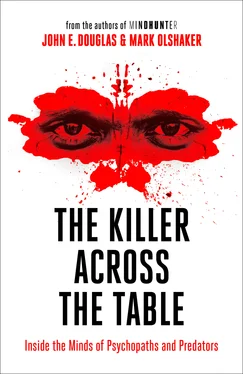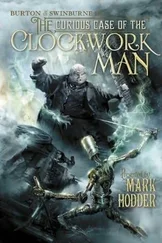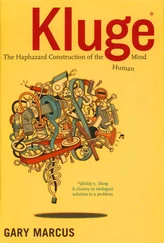But that is what the McGowan mental health files from his incarceration amounted to. Three individual reports, generated in January 1987, October 1988, and September 1991, stated that McGowan had admitted his guilt and appeared remorseful about the crime. All three had recommended parole. On the other hand, McGowan had never reached out or attempted to express remorse to Rosemarie or anyone else in Joan’s family.
On October 7, 1993, Dr. Kenneth McNiel, the principal clinical psychologist at the Adult Diagnostic and Treatment Center, met with McGowan. He was there at the request of the New Jersey state parole board. Specifically, the board wanted to assess the prisoner’s “(1) likelihood of violent acting-out; (2) general personality profile; (3) presence/absence of several psychological problems; and (4) treatment program recommendations.”
Dr. McNiel’s findings painted a substantially different picture, not only from the three previous reports, but also from the original ones conducted by Drs. Galen, Effron, and Revitch. According to Dr. McNiel, McGowan denied “any history of sexual fantasies or behaviors toward children prior to or subsequent to his crime.”
McNiel’s report stated that while
Mr. McGowan also denied any dissociative symptoms, his discussion of the present offense was notable for brief moments in which he would blank and look away while discussing the crime, which suggested a dissociative process. [I]t was clearly difficult for him to concentrate on specific memories of his crime.
HE CONCLUDED:
Mr. McGowan has made little or no progress in fully appreciating the extent of sexual deviance and violence that is apparent in his crime. Unfortunately it appears that he continues to primarily manage such negative aspects of himself through denial and repression, similar to the time of his crime.
Like the three previous reports, McNiel found “no evidence to indicate Mr. McGowan is at imminent risk of violent behavior,” but hedged himself by adding, “in a non-structured community setting, his ability to manage anger, rejection and feelings of sexual inadequacy remains open to question.”
Taken together, these reports underscored for me the vagaries of our understanding of the human mind and motivation, or even their relationship to the physical brain. Sometimes we can look at a mental symptom and link it directly to a physical problem in the brain or nervous system, but most of the time we can’t. Or, to take it one step further, sometimes we will say that a particular cruel, antisocial, or criminal action was the result of a mental or emotional disease. In other instances, we’ll say that the perpetrator wasn’t suffering from a mental disease per se, but had a “character disorder,” and therefore is more responsible for what he did. But what is the difference between a mental disease and a character disorder? A psychiatrist reading the DSM can give us a definitional answer, but will it really tell us anything about the distinction?
My colleagues and I on the criminal analysis side of behavior science operate from the premise that anyone who commits a violent or predatory crime is mentally ill. This is almost ipso facto, in that “normal” people do not commit such crimes. But a mental disorder, in and of itself, does not mean the perpetrator is insane, which is a legal, rather than a medical, term that has to do with culpability.
There have been many attempts to define insanity over the years, but in one way or another, they all go back to the M’Naghten Rule, formulated by the British courts in the wake of one Daniel M’Naghten’s attempt to assassinate British prime minister Sir Robert Peel in 1843. Shooting at point-blank range outside Peel’s London house, M’Naghten instead killed the prime minister’s private secretary Edward Drummond. M’Naghten, who suffered from delusions of persecution, was found not guilty by reason of insanity, and ever since, through multiple interpretations and permutations, the basic legal test of insanity in British and American courts has been whether the defendant could distinguish between right and wrong or was acting under a delusion or compulsion so strong that it negated that distinction.
Perhaps the closest we had to a genuinely insane predator was the late Richard Trenton Chase, who was convinced he needed to drink the blood of women to stay alive. When he was placed in a mental institution for the criminally insane and could no longer obtain human blood, he’d catch rabbits, bleed them, and inject their blood into his arm. When he could catch small birds, he would bite off their heads and drink blood. This was not a sadist who enjoyed inflicting pain and death on creatures smaller and weaker than him. This was an out-and-out psychotic, as opposed to a run-of-the-mill criminal sociopath. He committed suicide in his cell at age thirty by overdosing on antidepressant drugs he had saved up.
Still, there haven’t been many killers like Richard Trenton Chase, and this ambiguity around insanity and mental illness highlights one of the early objectives of our project to interview killers. The conversations alone were not enough. We knew that to be truly useful, we would have to find a way to systematize our results: create distinctions that could be applied more broadly, so that there was a vocabulary that extended beyond each individual case. Back in 1980, Roy Hazelwood, our sex crimes and interpersonal violence expert, was collaborating with me on an article about lust murder for the FBI Law Enforcement Bulletin. For the first time, instead of jargon borrowed from psychology, we employed a series of terms we thought would be more practical for crime investigators. We introduced concepts such as organized, disorganized, and mixed to describe behavioral presentations at crime scenes.
Roy put me in touch with Dr. Ann Burgess, with whom he had done previous research. Ann was a highly regarded author, professor of psychiatric mental health nursing at Boston College and the University of Pennsylvania School of Nursing, and associate director of nursing research for the Boston Department of Health and Hospitals. Along with Roy, she was one of the nation’s leading authorities on rape and its psychological impact. Interestingly, she had recently completed a research project at Boston College involving the accuracy of predicting heart attacks in men and thought there were interesting similarities in the “reverse engineering” required for her study and what we were aiming to do.
Ann was eventually able to secure a large grant from the National Institute of Justice that allowed us to conduct a rigorous study and publish our results. Bob Ressler administered the grant and served as the NIJ liaison, and with our input, we developed a fifty-seven-page document to be filled out for each offender interview, which we called the Assessment Protocol. There were categories for modus operandi, description of the crime scene, victimology, pre- and post-offense behavior, and how they were identified and apprehended, among many other elements. Since we had already established that neither recording the interviews nor taking notes was a good idea, as soon as we finished, we would fill out the interview document, using the subject’s own words, to the best of our memories.
When we finished our formalized study in 1983, we had thirty-six in-depth studies of offenders and 118 of their victims, primarily women. By this point we had enough experience and sophistication in the Behavioral Science Unit to offer profiling and case consultation on a formal basis. Bob Ressler and Roy Hazelwood continued with their teaching and research and consulted part time as their other duties allowed. I became the first full-time operational profiler and program manager of the Criminal Profiling Program, and eventually created a new unit. My first order of business was to “take the BS out of behavioral science and profiling.” I renamed our group the Investigative Support Unit, or ISU. It encompassed programs in profiling, arson and bombing, the Police Executive Fellowship Program, VICAP—the national Violent Criminal Apprehension Program, which involved logging and comparing cases between jurisdictions—and coordination with other federal law enforcement agencies, including the Bureau of Alcohol, Tobacco and Firearms, and the Secret Service.
Читать дальше












